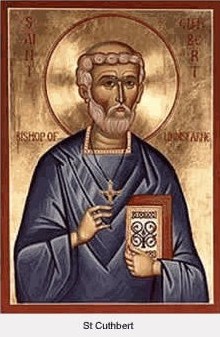CUTHBERT – PATRON SAINT OF THE
NORTH
 The early Christian Church in these islands was served by
some extremely able and devout men, Saint Columba and St
Aidan, St Chad and St Cedd, to name just a few. St Cuthbert of Melrose,
Lindisfarne and Durham is up there with them all, admired in his lifetime and
venerated after his death.
The early Christian Church in these islands was served by
some extremely able and devout men, Saint Columba and St
Aidan, St Chad and St Cedd, to name just a few. St Cuthbert of Melrose,
Lindisfarne and Durham is up there with them all, admired in his lifetime and
venerated after his death.
He was born round about 634 into a well to do Christian
Anglo Saxon family in Northumbria and, as was customary with the sons of the
wealthy, he was fostered and grew up training for a life as a warrior. Part of
his duties would include guarding the family livestock and from this activity,
the story of Cuthbert’s calling to the priesthood comes. He was out on a
hillside in Northumbria when he had a vision in the night sky of a light
descending to earth and then returning to heaven with, as he perceived it, a
human soul. This was the night that St Aidan had died on Lindisfarne. Cuthbert
went to the abbey of Melrose where he became a monk.
He moved with the Abbot Eata to set up a monastery at
Ripon and in 661 he became Prior of Melrose and his earliest missionary journeys
began. The Synod of Whitby brought some dissension with the church concerning
rites and practices and although a monk of the Celtic tradition, Cuthbert
adopted Roman customs becoming the prior at Aidan’s abbey of Lindisfarne where
he was able to bring the monks around to his point of view. From time to time he
retired to the Farne Islands to live the life of a hermit and in 676 he
relinquished his position as prior. However, by 685 his fame as a man of
holiness had spread and the King of Northumbria chose him to be bishop of
Hexham. Before long he had exchanged this see with his old mentor Eata and was
back at his beloved Lindisfarne. He devoted his life to preaching, teaching and
travelling around his diocese and his reputation as a healer and a prophet grew.
He died on Inner Farne on 20th March 687 and was buried at
Lindisfarne. Eleven years later a new shrine was prepared for him and it was
discovered that his body was incorrupt. Thus began Cuthbert’s the final
journeys.
Lindisfarne was destroyed in 875 by the Danes and the
monks fleeing the carnage took with them the shrine and relics of Cuthbert
around northern England and southern Scotland in search of a resting place
befitting their saint. Before they finally found a permanent home they rested at
Norham on Tweed, Ripon and Chester le Street finally arriving in Durham in 995
where a Saxon church was built over the shrine. Cuthbert’s relics were
translated into the new church in 999. Durham became a monastic see in 1083 and
a new Norman Cathedral was built with Cuthbert moving into it in 1104. Once
again his body was examined and was still found to be incorrupt. This was not
the end of the story. Cuthbert was moved again at the Reformation and again in
1828 but he now rests in peace in Durham Cathedral..
His cult was well established by the late seventh century
and a monk of Lindisfarne and the Venerable Bede both produced a Life of the
saint. The wanderings of the Lindisfarne monks had kept the cult alive and it
flourished in the Middle Ages. Several important manuscripts were associated
with Cuthbert including the Lindisfarner Gospels and the Gospel of St John
housed at Stonyhurst College. Bede’s life of the Cuthbert was in demand abroad
as well as at home. Stories of miracles were collected and manuscripts of his
Lives were produced. Durham became the centre of his cult which spread over much
of Scotland and England. Many churches are dedicated to him predominately in the
north but some are as far afield as East Anglia, Somerset and Cornwall. He is
commemorated in place names and geographical features of the Inner Farne where
he had spent years in prayer and solitude among the wildlife. As a hermit the
birds and seals had been his only companions and It is fitting that all the
Farne Islands have become a bird and animals sanctuary under the care of the
National Trust still enjoying the protection originally afforded to them by the
saint. His feast day is 20th March.
Barbara Hothersall
 The early Christian Church in these islands was served by
some extremely able and devout men, Saint Columba and St
Aidan, St Chad and St Cedd, to name just a few. St Cuthbert of Melrose,
Lindisfarne and Durham is up there with them all, admired in his lifetime and
venerated after his death.
The early Christian Church in these islands was served by
some extremely able and devout men, Saint Columba and St
Aidan, St Chad and St Cedd, to name just a few. St Cuthbert of Melrose,
Lindisfarne and Durham is up there with them all, admired in his lifetime and
venerated after his death.